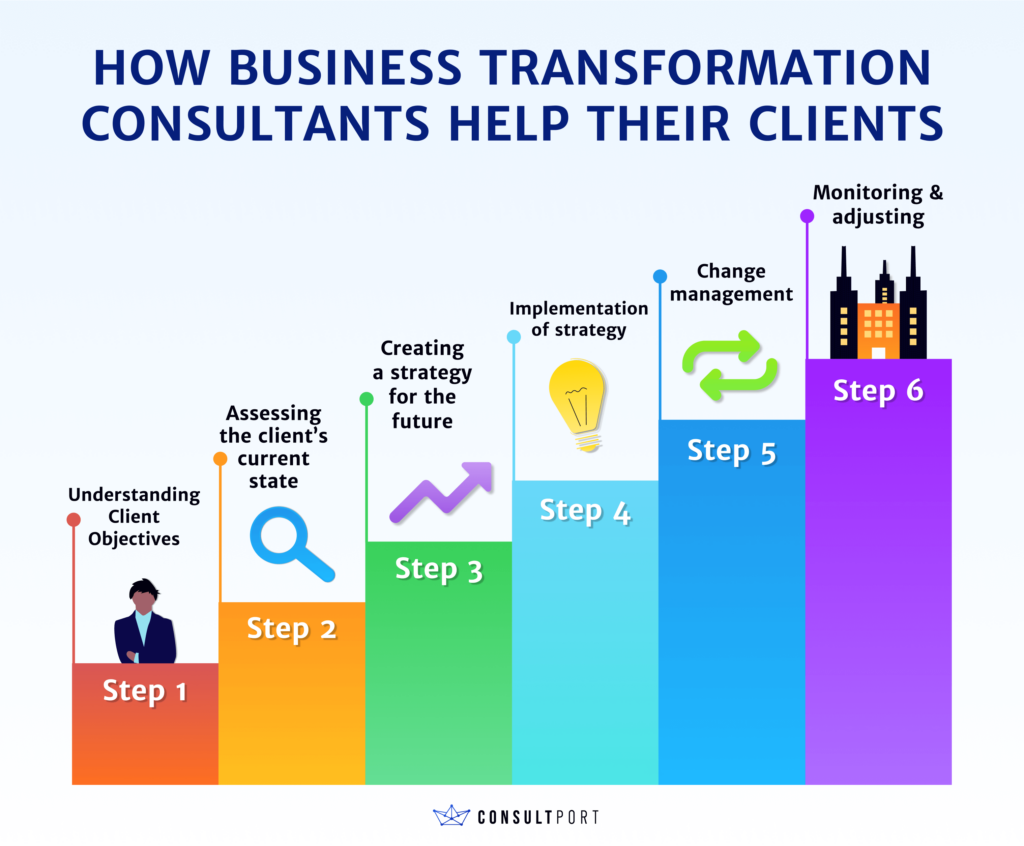Business Transformation Consulting, a Lucrative Career


Share this article

Have you wondered what the driving force behind successful business transformations is? In today's rapidly changing markets, companies face challenges ranging from technological advancements to shifting consumer preferences. And that’s when a business transformation consultant comes into play.
As the name suggests, these consultants come on board to transform the business. But that’s just a very basic way to put it. In this article, we’ll discuss how exactly business transformation consultants provide value to clients and how you can become one.
Now, let’s talk about what’s in it for you as a consultant. According to Glassdoor, the average salary of a business transformation consultant is $111,793 per year (as of 2023). However, if you have more work experience and top-notch consulting skills, the salary range could shoot up to $171,000. So, it’s fair to say that a career in this industry is rewarding.
Sounds exciting? Then read this article thoroughly.
As the name suggests, these consultants come on board to transform the business. But that’s just a very basic way to put it. In this article, we’ll discuss how exactly business transformation consultants provide value to clients and how you can become one.
Now, let’s talk about what’s in it for you as a consultant. According to Glassdoor, the average salary of a business transformation consultant is $111,793 per year (as of 2023). However, if you have more work experience and top-notch consulting skills, the salary range could shoot up to $171,000. So, it’s fair to say that a career in this industry is rewarding.
Sounds exciting? Then read this article thoroughly.
KEY TAKEAWAYS
- Business transformation consultants assist companies in adapting to the evolving business landscape by improving their processes, strategies, and technology.
- They create a future-focused transformation strategy aligned with organizational goals, industry trends, and market dynamics.
- Consultants facilitate effective communication for organizational change, conveying purpose, benefits, and impact, while addressing employee concerns and fostering buy-in.
- A qualification in business, management, or finance, along with some hands-on consulting experience is essential for joining this profession.
What Is a Business Transformation Consultant?
Imagine this: A CEO of a well-established company is struggling to make the right changes and grow the business. To make things more complicated, the market is evolving rapidly, with technological advancements, market shifts, and changing consumer preferences reshaping the playing field. Furthermore, his organization is grappling with outdated processes, rigid structures, and resistance to change among employees. Enter the business transformation consultant.
Simply put, a business transformation consultant is a strategic partner who works with companies to refresh their operations, processes, strategies, and technology. They don’t just scratch the surface—they dive deep into the intricacies of a company's structure, processes, and culture to identify areas for improvement and innovation. Let’s elaborate on this a bit more.
A business transformation consultant assesses their client company's current state by scrutinizing workflows, organizational structures, and technology frameworks. Then, they work with decision-makers to craft a bespoke transformation strategy tailored to address specific challenges and align with organizational goals. But that’s not it. To ensure long-term results, they lay the groundwork for sustained success by instilling a culture of innovation and providing ongoing support to help their clients navigate emerging trends.

Example:
Let’s suppose that a manufacturing company wants to shift its production processes to be more environmentally sustainable. The consultant would meet with key stakeholders to understand their sustainability goals, current processes, and any regulatory requirements. This is also the time when SMART goals can be laid down.
Example:
Let’s continue with the same example above. For the manufacturing company, the consultant would assess the current production methods, energy consumption, waste management processes, and employee awareness of sustainability practices.
Example:
In the sustainability example, the consultant could recommend purchasing new energy-efficient equipment, implementing waste reduction initiatives, and investing in eco-friendly production technologies.
Example:
For the manufacturing company, the implementation plan could include phases such as upgrading machinery, training employees on sustainable practices, and establishing partnerships with eco-friendly suppliers. Some KPIs might include tracking reductions in energy consumption, waste production, and carbon emissions, to name a few.

If you’re in for a quick (paid) change management crash course, check this out: Implementation & Change Management Strategy Course. It’s just €19. That’s like one week’s Starbucks coffee—consider it.
Example:
Continuing with the same example, the consultant, while implementing new changes in the manufacturing company, might organize meetings, and training sessions, and create communication materials to inform employees about the company's commitment to sustainability and how it will positively affect them and the environment.
Example:
To monitor the implementation process, the consultant regularly reviews energy consumption data, waste reduction metrics, and employee feedback to ensure that sustainability goals are being met. And if there are any deviations, adjustments to the plan may be necessary.
Alright, so that was the six-step process that a business transformation consultant can use to elevate a client’s business. However, it’s just one way to go about things. Remember, you can use a different approach to achieve business transformation goals for your clients.
Simply put, a business transformation consultant is a strategic partner who works with companies to refresh their operations, processes, strategies, and technology. They don’t just scratch the surface—they dive deep into the intricacies of a company's structure, processes, and culture to identify areas for improvement and innovation. Let’s elaborate on this a bit more.
A business transformation consultant assesses their client company's current state by scrutinizing workflows, organizational structures, and technology frameworks. Then, they work with decision-makers to craft a bespoke transformation strategy tailored to address specific challenges and align with organizational goals. But that’s not it. To ensure long-term results, they lay the groundwork for sustained success by instilling a culture of innovation and providing ongoing support to help their clients navigate emerging trends.
How Business Transformation Consultants Help Their Clients
Great. Now that you know what a business transformation consultant is, let’s dive a little deeper and understand how exactly they work with clients.
Step 1: Understanding client objectives
Before any transformation can begin, consultants must thoroughly understand the client's objectives, challenges, and long-term goals. This involves long and detailed discussions with key stakeholders, reviewing existing processes, and identifying areas for improvement.Example:
Let’s suppose that a manufacturing company wants to shift its production processes to be more environmentally sustainable. The consultant would meet with key stakeholders to understand their sustainability goals, current processes, and any regulatory requirements. This is also the time when SMART goals can be laid down.
Step 2: Assessing the client’s current state
Before implementing any changes, a detailed analysis of the current state of the client's business is essential. This includes evaluating organizational structure, business processes, technology infrastructure, and employee capabilities. A SWOT analysis can also be conducted during this stage to determine strengths and weaknesses and assess areas of transformation. This step is really crucial in identifying inefficiencies and areas for improvement.Example:
Let’s continue with the same example above. For the manufacturing company, the consultant would assess the current production methods, energy consumption, waste management processes, and employee awareness of sustainability practices.
Step 3: Creating a strategy for the future
Alright, now comes the fun part. Based on the data-gathering and assessment, consultants work with the client to define a clear vision of the future state. To be precise, they develop a transformation strategy that aligns with the client's goals, while taking into account industry trends, market dynamics, and potential disruptions.Example:
In the sustainability example, the consultant could recommend purchasing new energy-efficient equipment, implementing waste reduction initiatives, and investing in eco-friendly production technologies.
Step 4: Implementation of strategy
During this step, consultants create a detailed roadmap for implementing the transformation. This includes outlining specific tasks, assigning responsibilities, establishing timelines, and setting key performance indicators (KPIs) to measure progress. Moreover, consultants work hand in hand with the client's leadership team to consider potential risks and contingencies within the implementation plan.Example:
For the manufacturing company, the implementation plan could include phases such as upgrading machinery, training employees on sustainable practices, and establishing partnerships with eco-friendly suppliers. Some KPIs might include tracking reductions in energy consumption, waste production, and carbon emissions, to name a few.
Step 5: Change management
The fact is, organizational change is not as easy and straightforward as people may think. Did you know that 31% of CEOs get fired for poor change management? Furthermore, 70% of change initiatives don’t succeed. That’s why effective communication is crucial to manage resistance and ensure a smooth transition. Consultants help clients communicate the transformation's purpose, benefits, and impact to employees. They also provide change management strategies to address employee concerns and encourage buy-in.
If you’re in for a quick (paid) change management crash course, check this out: Implementation & Change Management Strategy Course. It’s just €19. That’s like one week’s Starbucks coffee—consider it.
Example:
Continuing with the same example, the consultant, while implementing new changes in the manufacturing company, might organize meetings, and training sessions, and create communication materials to inform employees about the company's commitment to sustainability and how it will positively affect them and the environment.
Step 6: Monitoring and adjusting
The thing about transformation is that it’s an ongoing process. It doesn’t end when the consultant winds up the project and moves on—it continues and is carried on by the client even after the consultant leaves. However, consultants work with clients to monitor the implementation, track KPIs, and make adjustments as needed. This may involve reassessing the strategy, refining processes, and addressing unforeseen challenges.Example:
To monitor the implementation process, the consultant regularly reviews energy consumption data, waste reduction metrics, and employee feedback to ensure that sustainability goals are being met. And if there are any deviations, adjustments to the plan may be necessary.
Alright, so that was the six-step process that a business transformation consultant can use to elevate a client’s business. However, it’s just one way to go about things. Remember, you can use a different approach to achieve business transformation goals for your clients.
What Does It Take To Become a Business Transformation Consultant?
Now you may be wondering, “Do I have what it takes to be a business transformation consultant?” Well, let’s find out.

And that brings us to the end of the article. On an ending note, it’s worth reiterating that business transformation consulting is a lucrative and rewarding profession. Not only this, but the job satisfaction that comes with helping clients achieve their goals is also priceless. So, if you have what it takes, take the first step forward and start your journey. All the best.
1. Education
If you have a relevant educational background, typically in business, management, finance, or a related field, it may be easier for you to get into this line of work. Most consultants who work as business transformation consultants hold a bachelor's degree, and some pursue advanced degrees such as an MBA.2. Consulting Experience
It may be difficult, if not impossible, to work as a business transformation consultant without prior experience in consulting. So, gain consulting experience by working with a consulting firm or within an organization's internal consulting team. This hands-on experience will expose you to various projects and challenges, allowing you to develop a diverse skill set.3. Industry certifications
Certifications such as PROSCI's Change Management Certification, Project Management Professional (PMP), and Certified Management Consultant (CMC) are widely recognized in the consulting industry. The qualifications provide a structured framework for understanding and implementing transformative strategies, and it also increases your credibility as a consultant. And if you’re short on time, you could also try Consultport Academy’s crash courses on consulting topics like strategy and change management.
(Image: Consultport Academy)
4. Networking
Well, this applies to almost any profession. You should build a strong professional network by attending industry events, joining relevant associations, and connecting with professionals in the consulting field. Networking can provide valuable insights, mentorship, and potential job opportunities.5. Client relationship management
You could be the best consultant out there, but if you don’t know how to deal with different types of clients, consulting, in general, may be difficult for you. So, learn how to build and maintain strong client relationships. You see, business transformation consultants must understand client needs, communicate effectively, and manage expectations throughout the consulting engagement.And that brings us to the end of the article. On an ending note, it’s worth reiterating that business transformation consulting is a lucrative and rewarding profession. Not only this, but the job satisfaction that comes with helping clients achieve their goals is also priceless. So, if you have what it takes, take the first step forward and start your journey. All the best.
Share this article
Premium content,
on a weekly basis.
on a weekly basis.
Subscription implies consent to our privacy policy.
×
Subscribe to our newsletters!
Discover our Consultant's Expertise
Ready to get access to the world’s best consultants?